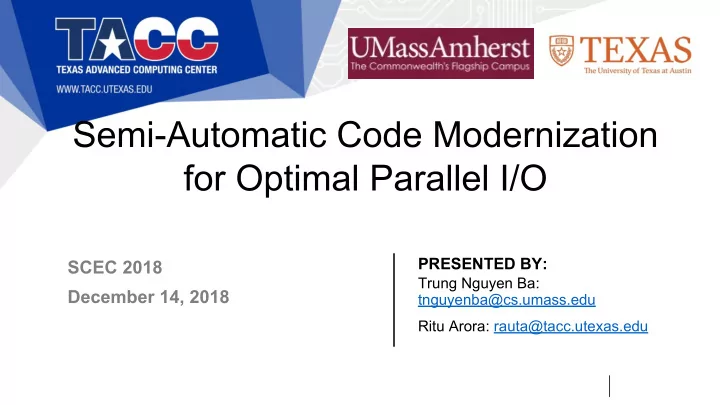

Semi-Automatic Code Modernization for Optimal Parallel I/O PRESENTED BY: SCEC 2018 Trung Nguyen Ba: December 14, 2018 tnguyenba@cs.umass.edu Ritu Arora: rauta@tacc.utexas.edu
Interactive Parallelization Tool (IPT)
IPT Design Overview
Parallel MPI I/O with IPT Input Program (C,C++) IPT Transformation Engine (ROSE compiler rules and patterns) Parallel I/O specification Constraints checking and analyses User confirmation Code Transformation Output Program
Writing/Reading ASCII Files User chosen the block of I/O code IPT inserts code calculating file offset and buffering file write/read statements IPT inserts the MPI I/O calls
Writing/Reading 1-D, 2-D arrays in Binary Files User chosen the block of I/O code IPT detects important writing/reading information IPT inserts MPI I/O and remove the serial I/O code IPT inserts the MPI I/O calls
Example of Optimizable I/O Patterns Optimizable 1-D array I/O Optimizable 2-D array I/O int a[100]; int a[100][100]; for ( int i =0; i < 100;i++) { for ( int i =0; i < 100;i++) { fprintf(f, "%d," ,a[i]); for ( int j =0; j < 100;j++) { } fprintf(f, "%d," ,a[i]); } }
Lustre filesystem ● File stripping to increase I/O bandwidth ○ Inserting stripe size ○ Inserting stripe count
Demo
Results and Evaluations Examples Serial Time IPT Parallel Manual Parallel Taken in Seconds Time Taken in Seconds Time Taken in Seconds 4 MPI processes used 4 MPI processes used 1-D Array - reading 42 0.55 0.39 1-D Array - writing 54 1.7 1.66 2-D Array - reading 36 0.53 0.55 2-D Array - writing 40 1.71 1.74 1-D integer array with 100,000,000 elements 2-D integer array with 10,000x10,000 elements
Examples Serial IPT Parallel Manual Parallel Total #LoC (#LoC Inserted-or-Deleted) / (#LoC) (#LoC Inserted-or-Deleted) / (Total #LoC) 1-D Array - reading 11 Lines deleted: 3 Lines deleted: 5 Lines added: 32 Lines added: 16 Total number of lines: 40 Total number of lines: 22 %age of code change: 87.5 %age of code change: 95.5 1-D Array - writing 13 Lines deleted: 3 Lines deleted: 6 Lines added: 36 Lines added: 15 Total number of lines: 46 Total number of lines: 22 %age of code change: 84.7 %age of code change: 95.5 2-D Array - reading 13 Lines deleted: 5 Lines deleted: 6 Lines added: 30 Lines added: 20 Total number of lines: 38 Total number of lines: 27 %age of code change: 92.1 %age of code change: 96.3 2-D Array - writing 18 Lines deleted: 5 Lines deleted: 7 Lines added: 38 Lines added: 24 Total number of lines: 51 Total number of lines: 35 %age of code change: 84.3 %age of code change: 85.6 LoC = Lines of Code
Conclusion ● Overview of parallelizing I/O code with IPT ● IPT supports both ASCII and Binary read and write ○ It also supports file stripping on Luster filesystem ● Performance: ○ IPT-parallel version has almost the same performance as the manual parallel version ○ Reducing the manual effort for parallelizing code for more than 80%
Acknowledgement The work presented in this paper was made possible through the National Science Foundation (NSF) award number 1642396.
Recommend
More recommend